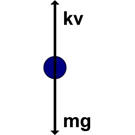Newton's 2nd law, drag
Problem:
An
object of mass m is launched from a stationary helicopter towards the Earth with
the speed v0. It experiences a force of air resistance F = -kv,
where k is a positive constant. The positive direction of all vector
quantities is downward.
(a) Draw a free body diagram showing the forces acting on the object.
(b) What is the terminal speed of the object?
(c) Find the speed of the object as a function of time, v0, m, g and
k.
(d) What is the direction of the acceleration of the object?
Solution:
- Concepts:
Newtonian mechanics
- Reasoning:
Fnet = ma is the equation of motion for the object
- Details of the calculation:
(a) Since velocity is downward, air resistance is upward, in the
opposite direction of gravity.

(b) When the object reaches terminal velocity, its acceleration is a = 0 and the
sum of all forces acting on the object is 0.
0 = mg - kvt, vt = mg/k.
(c) a = dv/dt
m(dv/dt) = mg - kv, dv/(v - mg/k) = -(k/m)dt
∫
dv/(v - mg/k) = -∫(k/m)dt
ln(v - mg/k) - ln(v0 - mg/k) = -(k/m)t
v = mg/k + (v0 - mg/k)e-(k/m)t
(d) a = dv/dt
a = (-k/m)(v0 - mg/k)e-(k/m)t
a = (g - v0k/m)e-(k/m)t
The acceleration can be positive, negative or zero.
If v0 < vt = mg/k, the acceleration is positive or
downward
If v0 > vt = mg/k, the acceleration is negative or upward.
If v0 = vt = mg/k, the acceleration is zero.
Problem:
A particle of mass m falls subject to the pull of gravity, with acceleration
g, and to the force of air resistance. The particle is dropped from height z =
z0. The initial velocity is zero. The force of air resistance may be modeled
as linearly dependent on the speed, so that the height of the projectile
satisfies
md2z/dt2 = -mg - bdz/dt.
(a) Solve the equation of motion for the particle's height z(t). Find the
terminal velocity.
(b) Take the b --> 0 limit and show that usual free-fall solution is obtained.
Solution:
- Concepts:
Newton's second law, integrating the equation of motion
- Reasoning:
The equation of motion is given.
- Details of the calculation:
(a) Let v = dz/dt, then mdv/dt = -mg -
bv.
Try a solution v = A + Be-kt.
v(t) = -(g/k) + (g/k)e-kt,
where k = b/m.
As t approaches infinity, v approaches vtermial = -g/k.
z(t) = z0 + ∫0t(-(g/k) + (g/k)e-kt')dt'
= z0 - (g/k)t + (g/k2)(1 - e-kt).
(b) As b
--> 0, k --> 0, e-kt = 1 - kt + k2t2/2 +...
.
z(t) = z0 - (g/k)t + (g/k2)( kt - k2t2/2)
= z0 - gt2/2.
Problem:
The forces acting on a sky-diver of mass m are the force of gravity and the
drag force due to the air. Assume the drag force is proportional to the
square of the speed. Find the diver's velocity as a function of time, and
the diver's terminal velocity vf. Assume vi = 0.
Hint: ∫dx/(a2 - x'2) = (1/a) tanh-1(x/a)
Solution:
- Concepts:
Newton's second law
- Reasoning:
Let the diver's mass be m and the coefficient of
proportionality between the drag force and v2 be mk.
mdv/dt =
mg - mkv2.
- Details of the calculation:
Terminal velocity vf = V:
dv/dt = 0 --> V2 = g/k.
In terms of V, dv/dt = g(1 - v2/V2),
dv/(V2 - v2) = (g/V2)dt.
∫0vdv'/(V2
- v'2) = gt/V2.
Integrating and solving for v we
get
v(t) = V tanh(gt/V).
Problem:
A boat with mass m is slowed by a drag force F(v). Its velocity decreases
according to the formula v(t) = c2(t - tf)2 for
t ≤ tf, where c is a constant and tf is the time a which
it stops. Find the force F(v) as function of v.
Solution:
- Concepts:
Newton's second law
- Reasoning:
F = mdv/dt.
- Details of the calculation:
a(t) = dv/dt = 2c2(t - tf).
F(t) = ma(t) = 2mc2(t - tf).
t - tf = -√(v)/c (Select the negative solution since t - tf is negative.)
F(v) = -2mc2√(v)/c = -2mc√(v).
Problem:
Assume a particle of mass m is subject to a damping and a driving force.
Its equation of motion is
dv/dt = -λv
+ (F/m)exp(iωt).
(The physics is represented by the real part of the equation.)
Find the general (real) solution
for v(t).
Solution:
- Concepts:
Solving a differential equation
- Reasoning:
We find the solution to the inhomogeneous equation dv/dt + λv =
(F/m)exp(iωt)
and add the solution of the homogeneous equation dv/dt + λv =
0.
-
Details of the calculation:
(a) inhomogeneous solution:
Try v = A exp(iωt), iωA + λA = F/m. A = (F/m)/(iω + λ).
homogeneous solution:
v = v0exp(-λt), v0 = arbitrary real constant.
general solution:
v = v0exp(-λt) - (F/m)exp(iωt)/(iω + λ).
Real part: v(t) = v0exp(-λt) + (Fω/m)sin(ωt)/(ω2
+ λ2) - (Fλ/m)cos(ωt)/(ω2 + λ2).
v(t) = v0exp(-λt) + [(F/m)/(ω2 + λ2)](ω sin(ωt)
- λ cos(ωt)).
